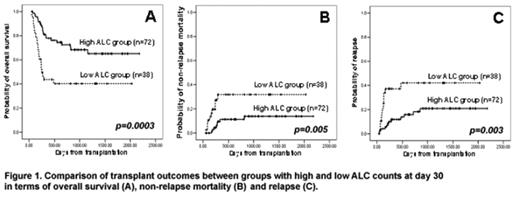Background: Early recovery of absolute lymphocyte count (ALC) is associated with improved outcomes following allogeneic and autologous stem cell transplantation for various hematological malignancies. The mechanism(s) underlying this observation is (are) unknown, but lymphocyte recovery may be a marker of immune reconstitution or graft-versus-leukemia activity. Objective: We assessed the incidence of early ALC recovery (defined as ALC ≥ 0.5 x 109/l by day+30) after peripheral blood stem cell transplantation (PBSCT) in recipients transplanted for AML or MDS and investigated its role as a potential prognostic marker for post PBSCT outcomes.
Methods: We reviewed the cases of 110 consecutive patients who underwent first allogeneic PBSCT from related donors for a diagnosis of AML (n=92) or MDS (n=18) at the Princess Margaret Hospital (Toronto, Canada) between 2000 and 2007. All patients received related donor transplants (matched related, n=103; mismatched related, n=7) and were alive at day+30. The primary outcome measure was incidence of early ALC recovery at day +30 post PBSCT. Endpoints were overall survival (OS), non-relapse mortality (NRM) and relapse incidence (RI) after PBSCT according to day +30 ALC ≥ 0.5 x 109/l (high ALC group) or < 0.5 x 109/l (low ALC group).
Results: The cohort included 51 women and 59 men. Median age at PBSCT was 51.7 years (range 18–71 years). Myeloablative conditioning (MAC) was employed in 65 (59%) patients (TBI based, n=62; Busulfan based, n=3), and 45 (41%) received reduced intensity conditioning (RIC). Median follow-up for survivors was 32 months. ALC ≥ 0.5 x 109/l by day+30 was reached by 72 patients (66%). There was no association between recipients’ gender, age at PBSCT or type of conditioning regimen and the probability of attaining ALC ≥ 0.5 x 109/l by day+30. Two-year OS in the entire cohort was 61%. Two-year OS of the high ALC group was superior to that of the low ALC group (72% vs. 40%, p=0.0003) (Figure 1A). The high ALC group also had significantly lower NRM (16% vs. 35%, p=0.005) (Figure 1B) and RI (21% vs. 42%, p=0.003) compared to the low ALC group (Figure 1C). No association between early ALC recovery and the incidences of acute or chronic graft-versus-host disease or incidence of CMV reactivation was observed. On multivariate analyses, low ALC at day +30 (ALC < 0.5 x 109/l) was an independent prognostic factor for inferior OS (p=0.02, HROS=2.27), higher RI (p= 0.01, HRRI=3.18), and higher NRM (p=0.03, HRNRM=2.1).
Conclusion: In AML and MDS early lymphocyte recovery by day 30 is associated with improved OS. Failure to attain early ALC recovery may identify patients with higher risk of relapse and NRM after PBSCT.
Comparison of transplant outcomes between groups with high and low ALC counts at day 30 in terms of survival (A), non-relapse (C).
Comparison of transplant outcomes between groups with high and low ALC counts at day 30 in terms of survival (A), non-relapse (C).
Disclosure: No relevant conflicts of interest to declare.


